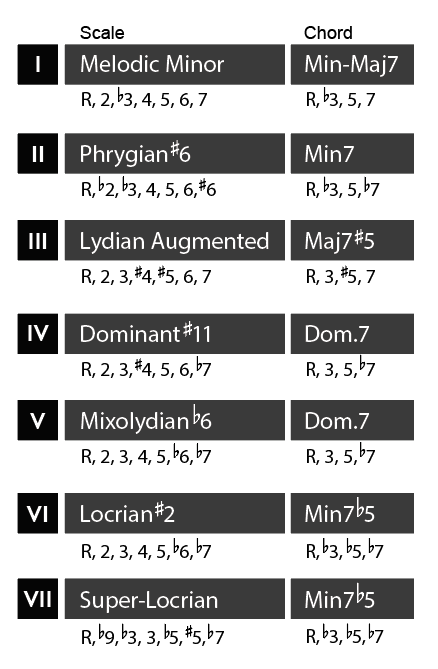| melodic_minor_scale_and_arpeggios.pdf |
You can focus on parts of the neck by breaking it up into 'r6 mode boxes'. These scale 'boxes' I term with the 'r6' meaning 'root is on the 6th string.' For instance, 'III-r6' represents the way the notes sit when you play the Phrygian scale with its root on the sixth string. This lines up as a box, or chunk of the fretboard which is easier to concentrate on, especially at first.
Just like the the Major scale, there are seven notes in the Melodic Minor. Each of these seven 'degrees' has a mode, chord, and arpeggio associated with it. Modes are simply the same notes of a scale arranged with a different note serving as the root. The arpeggio for each degree can be found by skipping every other note in the mode until the next octave is reached. An arpeggio is basically the notes of a chord played sequentially.
Below are the scales and chords for each degree of the Melodic Minor Scale:
I - Melodic Minor (R, 2, b3, 4, 5, 6, 7)
II - Phrygian #6 (R, b9, b3, 4, 5, 6, #6)
III - Lydian Augmented (R, 2, 3, #4, #5, 6, 7)
IV - Dominant #11 (R, 2, 3, #4, 5, 6, b7)
V - Mixolydian b6 (R, 2, 3, 4, 5, b6, b7)
VI - Locrian #2 (R, 2, #2, 4, b5, #5, b7)
VII - Super Locrian (R, b9, b3, 3, b5, #5, b7)
The accompanying chords are:
I - Min-Maj7 (R, b3, 5, 7)
II - Min #6 (R, b3, 5, b7)
III - Maj7 #5 (R, 3, #5, 7)
IV - Dom.7 #11 (R, 3, 5, b7)(#11)
V - Dom.7 b13 (R,3, 5, b7)(#13)
VI - Min7b5 (R, b3, b5, b7)
VII -Min7b5 (R, b3, b5, b7)
I recommend starting with the Melodic Minor arpeggios in the middle section of the PDF. Take four or five days and run over the arpeggios for one mode (probably start with Min/Maj7) in all the different r6 mode boxes. Maybe put on a relevant backing track and definitely a metronome. By the fifth day, you should really concentrate on connecting between the boxes and try to work horizontally or diagonally.
After you have the arpeggios, the scales are just the rest of the notes to flesh them out. Start with the most useful scales for playing over Dominants, like the Lydian Augmented and Super Locrian.
Finally, learn to run all the arpeggios within a particular mode box. This will reinforce both the scale pattern and the diatonic progression within the Melodic Minor.
While you are not going to necessarily find a lot of complex harmonic movements of the Melodic Minor in Jazz tunes, learning the diatonics of the Jazz Minor will give you greater facility at minor two-fives and the ability to super-impose these scales in other applications.


 RSS Feed
RSS Feed
